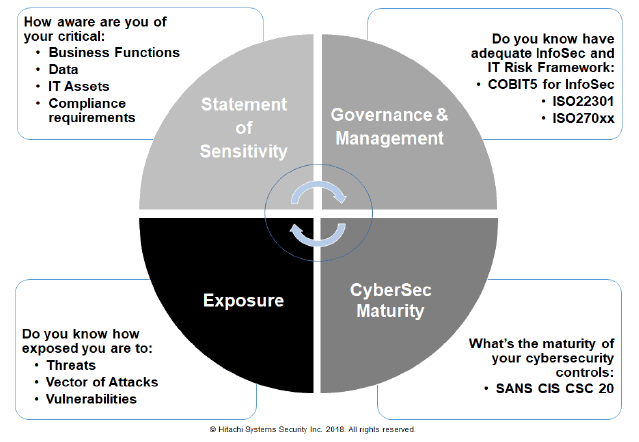A Cybersecurity Posture Assessment can be a useful first step for any organization that wants to identify where they’re at, what they’re missing and what they need to do to increase their cybersecurity maturity level. It can help organizations strengthen their cybersecurity defenses by providing a concrete cybersecurity roadmap.
In today’s era of digitalization and cybercrime, organizations are becoming increasingly worried about their ability to defend themselves against data breaches, cyberattacks and insider threats. In fact, the information security market is one of today’s most fast-growing markets and is projected to grow by 7% from $86.3 billion in 2017 to $93 billion in 2018, according to leading IT analyst firm Gartner. Cybersecurity spending is projected to exceed $1 trillion cumulatively from 2017 to 2018 with a compound annual growth rate of 12-15 percent.
This booming industry is crowded with a plethora of cybersecurity technology vendors, software providers, and service providers. This makes it increasingly challenging for organizations of all types and sizes to figure out which cybersecurity strategies will have the biggest impact and yield the best return on investment (ROI) to strengthen their cybersecurity defenses and improve their cybersecurity posture.
When it comes to choosing the right cybersecurity strategy, how are organizations supposed to know what is best? Should you conduct regular penetration testing, vulnerability assessments, control assessments, compliance audits, risk assessments, security program reviews, etc.? The list goes on! How often should this be done? And how can you be sure that these initiatives will actually pay off?
Unfortunately, companies are none the wiser about which cybersecurity service makes most sense for them. In recent years, we’ve seen a growing need for a cybersecurity service that will integrate all facets of cybersecurity into one comprehensive assessment approach, that will provide an overview of our customers’ internal and external cybersecurity posture – a true cybersecurity roadmap.
Before defining security posture assessments, you need to understand what a security posture is.
According to the National Institute of Standards and Technology (NIST SP 800-128), a cybersecurity posture relates to “the security status of an enterprise’s networks, information, and systems based on information security resources (e.g., people, hardware, software, policies) and capabilities in place to manage the defense of the enterprise and to react as the situation changes.”
In other words, your specific cybersecurity posture will indicate how healthy or resilient your organization is when it comes to cybersecurity, and how well it can defend itself against cyberattacks, breaches, and intrusions. Defining your cybersecurity posture is important because it will guide your entire cybersecurity strategy, determine your cybersecurity projects, and influence your cybersecurity spending throughout the years.
→ Want to self-assess your cybersecurity posture? Download our free checklist to find out!

A Cybersecurity Posture Assessment provides an overall view of the organization’s internal and external security posture by integrating all the facets of cybersecurity into only one comprehensive assessment approach. It is meant to help organizations define where they’re at in terms of their cybersecurity posture, what gaps they’re currently facing and what steps they need to take to improve their cybersecurity posture going forward.
Unlike a penetration test or a standard information security audit, a Cybersecurity Posture Assessment will provide C-Level Executives with clarity and direction in terms of their organization’s cybersecurity posture to maximize the ROI of their security-related expenses. It will help design and develop an appropriate cybersecurity roadmap within an overall security program and business continuity planning (BCP).
More specifically, it helps organizations assess and improve their cybersecurity posture by:
As outlined in Figure 1 below, a Cybersecurity Posture Assessment is usually based on four (4) principal assumptions:

Figure 1: The 4 Key Assumptions of a Cybersecurity Posture Assessment
Most probably yes.
In fact, most mature organizations in terms of cybersecurity don’t necessarily know what their cybersecurity posture is and how well they could face security incidents. They don’t always have a clear understanding of where they’re at, how they can align their cybersecurity spend with their business objectives or how they can follow a clearly-defined cybersecurity roadmap for continuous improvement.
This can result in a variety of issues, including wasted security expenses, misalignment between security initiatives and company objectives, overworked security staff and a lack of security direction in general.
A Cybersecurity Posture Assessment can be a much-needed exercise that will provide data-driven insights to guide your overall cybersecurity strategy.
As a general rule, a posture assessment will be useful to you:
When it comes to cybersecurity, we have learned that organizations are still confused about which strategies to choose to protect their data, maximize their cybersecurity spend and achieve demonstrable ROI. Regardless of which industry you operate in, knowing your cybersecurity posture is essential in building a long-term security strategy that will protect your organization, outline a concrete cybersecurity roadmap and help you strengthen your cybersecurity defenses over time.
Do you know what your current cybersecurity posture is? If you’re not sure, we’ve developed a handy-dandy checklist that will help you get a high-level overview of where you’re at in terms of your cybersecurity posture.